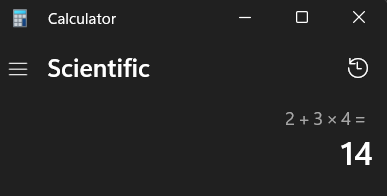💡𝚂𝗆𝖺𝗋𝗍𝗆𝖺𝗇 𝙰𝗉𝗉𝗌📱
- 1 Post
- 26 Comments

 1·4 months ago
1·4 months agoHmmm, I got around it (eventually), but it wasn’t through any of the methods mentioned - don’t remember what I did. Very annoying as I hate 11 so much I was actually going to roll back to 10 this week, now I’m worried if I do that then when I eventually have to come back to 11 I’ll be stuck with having to use my MS account for it.

 6·4 months ago
6·4 months ago“‘the next generation of Windows PCs’, differentiated by the AI experiences that will be exclusive to them”
No thanks. I’m good.

 2·6 months ago
2·6 months agoAs a Maths teacher, almost daily 😂

 12·6 months ago
12·6 months agoIf I left out the parentheses the answer would have been 20 instead of 14
Did you get that answer from the Windows calculator? That’s a bug in “Standard” mode. You need to put it in Scientific mode to get the right answer (I guess no-one has noticed that the “standard” mode is wrong, cos no-one uses it usually).


 12·6 months ago
12·6 months agothey’re not the same order of operations. If I left out the parentheses the answer would have been 20 instead of 14
No it wouldn’t. B E D M A S. I even showed you on the number line why it’s 14 (which you’ve ignored). No wonder you don’t understand what I’m talking about if you think the answer is 20.
Stop assuming my example are incorrect or I have made some kind of error
There’s no assumption - I’m a Maths teacher. If you think the answer is 20 then you did make an error.
you’re some kind of AI designed to maximize my frustration
No, just trying to show you how Maths works. Some other people thanked me.

 12·6 months ago
12·6 months ago2 + 3 * 4 = 14 using the order of operations [parenthesis, multiplication, addition].
2 + (3 * 4) = 14 using the order of operations [parenthesis, addition, multiplication].
There, two different orders of operation, the same answer.
But they’re the same order of operations - you didn’t do multiplication last in the second example, you did it first, because it was inside brackets.
In terms of BEDMAS…
2+3x4=2+12=14 M A
2+(3x4)=2+12=14 B A
Same order of operations rules! This is what I keep saying to you - there’s no way around it! We didn’t choose it, it’s a law of nature. The only thing we chose is how to write it. It’s the same with the Laws of Physics - they are laws of nature, and we just chose how to write them.
You changed my equation, so of course it is going to be wrong
No, I didn’t. I simply substituted addition for multiplication, as per the definition of multiplication as shorthand for addition, which in the previous comment you weren’t contesting. Analogy, if you wrote 2, and I substituted 1+1, then that doesn’t change the answer because 1+1=2. In the same way, 4x10=4+4+4+4+4+4+4+4+4+4
You said…
does 3 + 4 * 10 + 7 equal 77
And so I did the Maths. We know, by definition 4x10=4+4+4+4+4+4+4+4+4+4, therefore I can swap those around with each other and it doesn’t change the answer. So…
3+4+4+4+4+4+4+4+4+4+4+7=50, which does not equal 77! The answer is wrong, because the answer is, you know, wrong.
If I changed your 2 + 3 * 4 to (2 + 3) * 4, then then your answer would be 20 and that would be “wrong”.
No, because adding brackets around addition does change the answer, because now you’re doing the addition first, because it’s inside brackets. (2+3)x4 does equal 20, and 2+3x4 does equal 14 - they are 2 different equations, and have different answers. You changed the answer when you added the brackets to say “do this addition first instead of the multiplication”.
right answer is 14 because that is what the order of operations give us
NO, because that’s what arithmetic gives us - nothing to do with order of operations.
Here it is on a number line (no order of operations involved at all)…

And now, since we already know that the answer is 14, we can deduce the order of operations rules needed to make it so… which is multiplication before addition, and that is because multiplication is a shorthand form of addition! There are no other order of operations rules which work, only this works.

 12·6 months ago
12·6 months agoWell then it sounds like we agree
If you think that then you haven’t understood anything I’ve said
It seems like we agree that we can’t change the order of operations without changing the equations
No, we can’t change the order of operations without changing the definitions of the operators. We have to do multiplication before addition because multiplication is shorthand for addition. If you wanted to have a “different” order of operations, where we didn’t do multiplication before addition, then multiplication can’t be shorthand for addition anymore. To have a “different” order of operations, you could swap the definitions around, so that addition is shorthand for multiplication, and then yes, you would be doing addition before multiplication, but that’s the only way you can change the order of operations - by changing the definitions of the operators to begin with… and you would still end up with what we have now, except you’re calling addition “multiplication” and calling multiplication “addition”. All you would’ve done in reality is swapped the names around.
All I was saying was that we could use any order of operations we want
No, we can’t. And yes, you’re only saying that - you haven’t actually tried it. You gave me some examples which I proved don’t work, and yet you’re still saying the same thing whilst doing absolutely no Maths at all to back up that claim - it’s just words, and I’m showing you that it doesn’t work.
It’s just a way of interpreting the equation.
As with anything in Maths, there is a right way, and a wrong way. Only one way works. You might as well say “we could interpret 1+1 as equal to 3”. Try doing some actual Maths using 1+1=3 and let me know how far you get.
As long as we update the equations
The definitions.
So it doesn’t really matter which order of operations we use.
It really does, otherwise you just get wrong answers. Again, you haven’t actually tried doing it a different way, you just keep saying we could do it a different way (even though actually trying to do it a different way proves it doesn’t work).
I’m very confused how we got here in the first place
Because you’re still saying the same thing you said to begin with - that we can “choose” to use a different order of operations. No we can’t. The order of operations rules come directly from the definitions of the operators. If we define multiplication as being a shorthand form of addition, then that means we have to do multiplication before addition, it’s that simple, yet you continue to not see it. Doing addition before multiplication only gives wrong answers.
By the way, you can stop expanding x * 3 = x + x + x.
No, you can’t - they’re the same thing! That’s like saying “By the way, you can stop writing Maths as Mathematics”. One is just an abbreviation of the other, and you’re failing to see how multiplication being an abbreviation of addition means there’s only one right answer and we can only get that answer by doing multiplication before addition, hence the order of operations rules!
I understand how multiplication works
Apparently not, or you’d understand why the order of operations rules are what they are.
2+3x4=2+3+3+3+3=14. That’s it, that’s the only correct answer by definition (I didn’t use any order of operations rules there, just the definition of multiplication as shorthand for addition). Now, show me “a different order of operations” which still gives 14 as the answer. This is what your claim is, so prove it!
I just don’t find it a very convincing argument
It’s a proof. If you get the wrong answer with a different set of order of operations, then you can’t use that order of operations. We can only use order of operations which give the right answer (noted that you ignored my point about 490 vs. 77 - you keep ignoring every time I point out why what you said is wrong).
I wouldn’t be surprised if it was the basis for why we have the current order of operations
It is!!
But I don’t think it limits the order of operations we could use
IT DOES. This is what you’re failing to understand - the order of operations rules come from the definitions of the operators themselves, and only one way works. Literally the only way to change the order of operations rules is to change the operators themselves. i.e. their definitions. As long as multiplication is defined as being shorthand for addition, you’ll still have to do multiplication before addition, there’s literally no other way to get the right answer, hence there is only one set of order of operations rules which works - all other variations only give the wrong answer.

 12·6 months ago
12·6 months agobut none of that has anything to do with order of operations
Yep, you nearly had it there. I’ve been saying this repeatedly in my proofs, but you’ve been missing what that means.
Using parentheses we can ignore order of operations altogether
Only if you put them in the right place! With your example (7x10)+7=77, if we move the brackets 7x(10+7)=490, which is a different answer… which demonstrates why we can’t change the order of operations - you get different answers. The order of operations rules are there to make sure everyone gets the same answer from the same expression.
Also, using brackets isn’t ignoring the order of operations rules - brackets are part of the order of operations rules.
does 3 + 4 x 10 + 7 equal 77
I already addressed a similar question like this from you in my previous post, and you’ve ignored my answer (sigh). I’ll do this again and if you ignore my response again I’m giving up (it seems to me that you’re just being disingenuous now, ignoring my responses to your examples which prove they don’t work).
3+4x10+7
Recall that by definition - i.e. this is nothing to do with order of operations - 4x10=4+4+4+4+4+4+4+4+4+4
therefore…
3+4x10+7=3+4+4+4+4+4+4+4+4+4+4+7=50, which is not 77, so no, 3+4x10+7 does not equal 77, and again, that has nothing to do with order of operations, that is only using the definition of multiplication as repeated addition.
Assuming we use a completely reversed order of operations, we can get 77 this way. (7 * 10) + 7
Huh?? That’s not a reversed order of operations - that’s our current order of operations! Multiply before adding!
This implies that the order of operations alone does not give you the correct answer
WTH?! It PROVES that order of operations alone gives you the right answer. (7x10)+7=77. 7x10+7=77. Same answer, no brackets needed! Because of the order of operations rules.
And because you can get the correct answer with any order of operations given that the equation is written correctly
No, you can’t. 7+10x7 is written correctly, and we know the answer is 77. Let’s try a different order of operations and do addition first. 7+10x7=70x7=490 which isn’t 77, so it’s wrong. There is only one order of operations which gives the correct answer of 77, and that’s multiplication before addition and that’s because multiplication is defined as being shorthand for addition!
it follows that the order of operations is not critical for computation
I’ve shown you, repeatedly, that in fact it is. 490 is not equal to 77.
put it plainly the order of operations does not matter
Only if getting the right answer “does not matter”.
We could use any order of operations and still do math correctly
In what world exactly are 490 and 77 the same answer?

 12·6 months ago
12·6 months agoHow did we start with 14?
It was just a number I picked for the proof - any number works!
Why couldn’t we start with 77?
We could! Let’s go…
Teacher is writing a test. Decides the next question to be written will have 77 as the answer. How else can we write that? Let’s start with 7+70. We know the answer to that is 77 because…
- it’s what we started with
- we can show it’s so on the number line - start at 0, jump 7, jump 70, where are we now? 77!
Now, we can also write that as a repeated addition. i.e. 7+10+10+10+10+10+10+10 - yet another way that we can write 77 (which we already know is the answer). What else?
We also know, by the definition of multiplication, that multiplication is short for repeated addition, so now let’s rewrite that as 7+10x7, and we still know that the answer to this is 77 - all we have done is rewrite it in different ways based on the definitions of operators.
So now we need to look at what order of operations rules we need to make sure anyone doing this gets 77, because we already know the answer is 77!
So let’s try addition first…
7+10x7=17x7=119. Nope, not 77, that doesn’t work.
Now let’s try doing multiplication first…
7+10x7=7+70=77. Yes! We got the right answer. Welcome to our first order of operations rule - multiplication before addition.
Can we start with 2 + 3 * 4 + 5 = 14
Let’s see…
First let’s pull out the 2…
14=2+12
Now let’s pull out that 5…
14=2+7+5.
Can we make that 7 in the middle equal to the 3x4 you wrote? No, we can’t. 3x4 by definition is equal to 3+3+3+3, which is equal to 12, which isn’t equal to 7, so no, we can’t write 14=2+3x4+5 by the definition of the operators of add and multiply.
Again, no order of operations in there, simply can we write this with our current Maths operator definitions, and the answer is no, we can’t. i.e. the order of operations rules are derived from the definitions of the operators themselves. We can’t write 14=2+3x4+5 while 3x4 is still defined to mean 3+3+3+3. To make your equation work, we would have to make 3x4=7, which is what + already means, and why would you make the multiply operator mean the same thing as the addition operator? That would be redundant.
It looks to me like you’re jumping from floating island to floating island
I’m going from proof to proof.
I don’t know how you’re doing it.
By knowing how arithmetic works. The rules of Maths work for all numbers and all operators - they were written for that specific purpose!
I really don’t know how to bridge this gap
Are you a visual learner? Do you want me to actually draw it up on a number line? Cos that’s what it all boils down to - jumps on the number line. We’re only dealing with 1 Dimensional Maths here.

 12·6 months ago
12·6 months agoI think without order of operations, 2 + 3 * 4 has no answer… You think that it does have an answer
I started with the answer. I started with 14, and then I found different ways to write that using Maths definitions. The first different way to write that was 2+3+3+3+3. We know that’s equal to 14 because…
- that’s what I started with
- it’s just a simple number line exercise anyway (which is what everything boils down to) - start at 0, jump 2, jump 3, jump 3, jump 3, jump 3. Where am I on the number line now? 14.
Then I went “what’s yet another way we can write that using Maths definitions?”. Well, 3x4 is shorthand for 3+3+3+3, so now we can also rewrite that as 2+3x4, and we know the answer to that is 14 because that’s what we started with, and now, ok we’re happy with that, we’ll make that the question to use in the test.
Note that I haven’t done anything using order of operations rules yet, I’ve only rewritten the answer using different Maths notation definitions.
And now, as we already know, any order of operations rules which don’t get 14 as the answer are wrong, so we know that the only order of operations rules which get us 14 is M A… and the reason that they’re the only rules which work is because multiplication is shorthand for addition, so we have to expand that before we do addition. In other words, the steps we have to take to solve it - the order of operations rules - have to be in the opposite order to which the expression was created. An analogy to this is if I take 3 steps East, then I take 3 steps West to get back to where I started (just like we do on a number line) - if I take 3 steps North then I end up somewhere else than where I started, which is the wrong destination if I’m wanting to get back to where I started.

 12·6 months ago
12·6 months agothe order of operations is based on consensus and that any order could be used
No, as per example I gave, if you changed the order to addition first, you get a different answer (20 instead of 14), therefore demonstrably you can’t use a different order of operations. You can only have a different order if you have different definitions of the operators to begin with… and again the order of operations would be derived from what definitions you used in that case.
I still think this claim is true
So you didn’t understand the proof then.
your rationale is probably the basis for the current order of operations that we use
It’s not my rationale - it’s a mathematical proof. We started with 14. We therefore know any rules we make have to end up back at 14. Any rules which don’t lead you back to 14 are demonstrably wrong and ruled out. That is the whole purpose of the rules of Maths in the first place - there is only 1 correct answer, and we have to have rules which can only give you that 1 answer when you follow them. It’s the same thing the original authors of the order of operations would’ve done. There’s no “consensus”, there’s just a Mathematician doing Maths and arriving at the rules which work. Then tells others what they are so that they don’t have to go through working it out themselves (though some might if they want to confirm that what they’ve been told is correct. As I said, that’s the beauty of Maths - you can do the Maths yourself and confirm that what you’ve been told is correct, like I just did).
But it doesn’t prevent us from using any other order of operations.
Of course it does. If you try using a different order of operations you no longer get 14 (as demonstrated when we do addition before multiplication with our current operator definitions).

 11·6 months ago
11·6 months agoYou are saying that 14 is the correct answer because of the order of operations
No, I am saying that is because that’s the number that we started with and we wrote the expression based on the operator definitions.
Let me try this again, but be more explicit about each step…
Teacher is writing a test. Has decided the answer for this question is going to be 14. What can he make the question? Well, we can throw in some addition, so let’s change it to 2+3+3+3+3. What else can we do?
Well, that 3+3+3+3 part there, we have a shorthand version of that in multiplication, that being 3x4, so now let’s change it to 2+3x4.
So, now we’ve turned 14 into 2+3x4. None of that had anything to do with order of operations, just the definitions of the operators - + means addition, and x is shorthand for multiple additions.
So, we already know that the answer is 14, because that’s what the teacher started with.
Now we need some rules of Maths to make sure that anyone who tries this question gets 14 as the answer.
And as we already saw, we have to do multiplication first or we arrive at the wrong answer - 20. And the reason we can only get the correct answer from doing multiplication first is because multiplication is shorthand for repeated additions, which was the first step the teacher made from having started from 14.
Similarly, we have defined exponents as being shorthand for multiplication, so for the very same reason we will need to solve exponents before we solve multiplication or we won’t end up at 14.
And welcome to the order of operations rules! As I said, they are a natural consequence of the way that we have defined the operators. So, with the way we have defined addition, multiplication, and exponents, solving any such expression requires that we do them in the order E M A. In other words, we have to undo all the shorthand in the opposite way to how it was written to begin with, until we end up with just additions, and from there we arrive at the correct answer of 14.
Let’s say though, way back in time, that instead they had defined exponents as shorthand for multiplication, and x as shorthand for exponents. Then, with these different definitions the order of operations rules would be M E A (because these definitions have exponents and multiplication the opposite way around to how we actually have defined them).
Do you see it now? If there’s something you don’t understand, then just ask me.

 11·6 months ago
11·6 months agoOk, but why does 2 * 3 = 2 + 2 + 2 mean that we should prioritize multiplication and division over addition and subtraction?
Because multiplication is shorthand for addition, and if you don’t expand it before doing the addition you get wrong answers. Let me show you…
Multiply first (i.e. correct)
2+3x4=2+3+3+3+3=14 - the right answer, by the very definition of 3x4=3+3+3+3
Now let’s see what happens if we do the addition first…
2+3x4=5x4=5+5+5+5=20 - which we know is the wrong answer! (because we already know the right answer is 14, because we already know that the actual original fully expanded expression was 2+3+3+3+3, so the rules of Maths have to guide us back to getting the same thing the original author started with, or it all breaks down! The author took 2+3+3+3+3 and wrote it as 2+3x4, so the rules of Maths have to make sure when we see that we get back to 2+3+3+3+3)
So the fact that we know multiplication is shorthand for addition, means we have to multiply before we add. Similarly, exponents are shorthand for multiplication (2³=2x2x2), so we have to do exponents before we do multiplication… which we have to do before we do addition! It all comes from what these very things have been defined as meaning in the first place.
I’ll take a source if you got one
Well, I just showed you by doing the Maths myself, which is one of the great things about Maths - some things you can prove it to yourself! :-) And that’s another topic I wrote about here and here.
P.S. feel free to read through and use my thread on order of operations.
inside radicals
I had to look up what that meant (should’ve done that the first time - sorry) - have never heard that before, must be a local terminology.
So, square roots (or other roots) can be expressed as an exponent - e.g. the square root of 2 is the same as 2 to the power ½ - so that’s covered by “E”, exponents! (or I for Index, or O for to the Order of, depending on your area)
I appreciate your mention of the importance of teaching the difference between operators and terms
Thank you.
My pedagogical background is in the sciences and I’m much better at doing math than teaching it
Oh god, welcome to why I have so many people argue with me, a Maths teacher, about it. There’s a whole bunch of Youtubes and blogs out there by Physics majors. I’m like “OMG, why are you trusting someone with a Physics major over someone with a Maths major - god help me”.
I would like if math classes (in my area) did more explicitly teach the difference between terms and operators
So what area are you in? A country will do. You said PEMDAS so I’m guessing the U.S.? I’ve heard via Youtubes/blogs that indeed there is more confusion with what is taught there, but I ended up Googling for U.S. textbooks, and found the same thing being taught in the textbook, so I’m not sure where this “that’s not what they teach in the U.S.” is coming from (why I was Googling for U.S. textbooks in the first place). Is the standard of teachers there actually worse than elsewhere? Or is it perhaps (possibly more likely) that there’s just more U.S. people posting, therefore more people who’ve forgotten the actual rules, and are just (as I’ve seen many times) they’re just blaming it on what they were taught (which I’ve usually found isn’t true at all).

 13·6 months ago
13·6 months agoYour argument is circular in nature
No it isn’t. The order of operations rules are derived from the definitions of the operators - there’s nothing circular about that.
The right answer is dependent upon the order that you do the operations
And so to get the correct answer, you have to do the operations in the correct order, yes.
So you can’t use the argument that the order of operation matters
But you just said it did when you said “The right answer is dependent upon the order that you do the operations”!
if you do the math not using the correct order of operations, the answer comes out incorrectly
Exactly! Glad you agree with me. :-)
we could just do away with order of operations all together and explicitly use parentheses everywhere
Except I showed here that most people put brackets in the wrong place to begin with.
So there’s nothing inherently correct about our current order of operations
I already gave the proof of why it is. We already know that 2x3=2+2+2 by definition, so therefore 2+2x3=2+6=8. If you did addition first you’d get 2+2x3=4x3=12, which is demonstrably wrong. Welcome to how the order of operations rules were derived to begin with.
I will say that I like it and that it makes sense to me
It makes sense because it’s been proven to be correct.
I’ve taught a class of kids that has various disabilities. Having a disability doesn’t make you stupid.
But then you would have to define what a “Group” is as well, adding yet another definition needing to be remembered. Terms are actually defined, and cover the first 2 steps, and then the rest are operators (binary then unary).




Yep, “change anything the users like just the way it is”